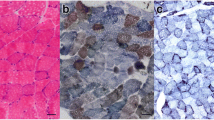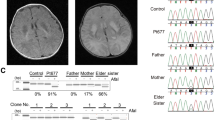Abstract
Defects in the respiratory chain or mitochondrial ATP synthase (complex V) result in mitochondrial dysfunction that is an important cause of inherited neurological disease. Two of the subunits of complex V are encoded by MT-ATP6 and MT-ATP8 in the mitochondrial genome. Pathogenic mutations in MT-ATP6 are associated with the Leigh syndrome, the syndrome of neuropathy, ataxia, and retinitis pigmentosa (NARP), as well as with non-classical phenotypes, while MT-ATP8 is less frequently mutated in patients with mitochondrial disease. We investigated two adult siblings presenting with features of cerebellar ataxia, peripheral neuropathy, diabetes mellitus, sensorineural hearing impairment, and hypergonadotropic hypogonadism. As the phenotype was suggestive of mitochondrial disease, mitochondrial DNA was sequenced and a novel heteroplasmic mutation m.8561C>G in the overlapping region of the MT-ATP6 and MT-ATP8 was found. The mutation changed amino acids in both subunits. Mutation heteroplasmy correlated with the disease phenotype in five family members. An additional assembly intermediate of complex V and increased amount of subcomplex F1 were observed in myoblasts of the two patients, but the total amount of complex V was unaffected. Furthermore, intracellular ATP concentration was lower in patient myoblasts indicating defective energy production. We suggest that the m.8561C>G mutation in MT-ATP6/8 is pathogenic, leads biochemically to impaired assembly and decreased ATP production of complex V, and results clinically in a phenotype with the core features of cerebellar ataxia, peripheral neuropathy, diabetes mellitus, and hypergonadotropic hypogonadism.



Similar content being viewed by others
References
Gorman GS, Schaefer AM, Ng Y et al (2015) Prevalence of nuclear and mitochondrial DNA mutations related to adult mitochondrial disease. Ann Neurol 77:753–759
Holt IJ, Harding AE, Petty RK, Morgan-Hughes JA (1990) A new mitochondrial disease associated with mitochondrial DNA heteroplasmy. Am J Hum Genet 46:428–433
de Vries DD, van Engelen BG, Gabreëls FJ, Ruitenbeek W, van Oost BA (1993) A second missense mutation in the mitochondrial ATPase 6 gene in Leigh’s syndrome. Ann Neurol 34:410–412
Duno M, Wibrand F, Baggesen K, Rosenberg T, Kjaer N, Frederiksen AL (2013) A novel mitochondrial mutation m.8989G>C associated with neuropathy, ataxia, retinitis pigmentosa—the NARP syndrome. Gene 515:372–375
Pitceathly RD, Murphy SM, Cottenie E et al (2012) Genetic dysfunction of MT-ATP6 causes axonal Charcot-Marie-Tooth disease. Neurology 79:1145–1154
Pfeffer G, Blakely EL, Alston CL et al (2012) Adult-onset spinocerebellar ataxia syndromes due to MTATP6 mutations. J Neurol Neurosurg Psychiatry 83:883–886
Rantamaki MT, Soini HK, Finnila SM, Majamaa K, Udd B (2005) Adult-onset ataxia and polyneuropathy caused by mitochondrial 8993T>C mutation. Ann Neurol 58:337–340
Synofzik M, Schicks J, Wilhelm C, Bornemann A, Schöls L (2012) Charcot-Marie-Tooth hereditary neuropathy due to a mitochondrial ATP6 mutation. Eur J Neurol 19:e114–e116
Schmitz-Hubsch T, du Montcel ST, Baliko L et al (2006) Scale for the assessment and rating of ataxia: development of a new clinical scale. Neurology 66:1717–1720
Schmitz-Hubsch T, Coudert M, Bauer P et al (2008) Spinocerebellar ataxia types 1, 2, 3, and 6: disease severity and nonataxia symptoms. Neurology 71:982–989
Kloss-Brandstatter A, Pacher D, Schonherr S et al (2011) HaploGrep: a fast and reliable algorithm for automatic classification of mitochondrial DNA haplogroups. Hum Mutat 32:25–32
van Oven M, Kayser M (2009) Updated comprehensive phylogenetic tree of global human mitochondrial DNA variation. Hum Mutat 30:E386–E394
Bendl J, Stourac J, Salanda O et al (2014) PredictSNP: robust and accurate consensus classifier for prediction of disease-related mutations. PLoS Comput Biol 10:e1003440
Martikainen MH, Kytovuori L, Majamaa K (2013) Juvenile parkinsonism, hypogonadism and leigh-like MRI changes in a patient with m.4296G>A mutation in mitochondrial DNA. Mitochondrion 13:83–86
Shoubridge EA, Johns T, Boulet L (1996) Use of myoblast cultures to study mitochondrial myopathies. Methods Enzymol 264:465–475
Leary SC, Sasarman F (2009) Oxidative phosphorylation: synthesis of mitochondrially encoded proteins and assembly of individual structural subunits into functional holoenzyme complexes. Methods Mol Biol 554:143–162
Yan LJ, Forster MJ (2009) Resolving mitochondrial protein complexes using nongradient blue native polyacrylamide gel electrophoresis. Anal Biochem 389:143–149
Yang SH, Sarkar SN, Liu R et al (2009) Estrogen receptor beta as a mitochondrial vulnerability factor. J Biol Chem 284:9540–9548
Rodenburg RJ (2011) Biochemical diagnosis of mitochondrial disorders. J Inherit Metab Dis 34:283–292
Aure K, Dubourg O, Jardel C et al (2013) Episodic weakness due to mitochondrial DNA MT-ATP6/8 mutations. Neurology 81:1810–1818
Jonckheere AI, Hogeveen M, Nijtmans LG et al (2008) A novel mitochondrial ATP8 gene mutation in a patient with apical hypertrophic cardiomyopathy and neuropathy. J Med Genet 45:129–133
Ware SM, El-Hassan N, Kahler SG et al (2009) Infantile cardiomyopathy caused by a mutation in the overlapping region of mitochondrial ATPase 6 and 8 genes. J Med Genet 46:308–314
Imai A, Fujitac S, Kishitad Y et al (2016) Rapidly progressive infantile cardiomyopathy with mitochondrial respiratory chain complex V deficiency due to loss of ATPase 6 and 8 protein. Int J Cardiol 207:203–205
Houstek J, Klement P, Hermanska J et al (1995) Altered properties of mitochondrial ATP-synthase in patients with a T > G mutation in the ATPase 6 (subunit a) gene at position 8993 of mtDNA. Biochim Biophys Acta 1271:349–357
Nijtmans LG, Henderson NS, Attardi G, Holt IJ (2001) Impaired ATP synthase assembly associated with a mutation in the human ATP synthase subunit 6 gene. J Biol Chem 276:6755–6762
Wittig I, Meyer B, Heide H et al (2010) Assembly and oligomerization of human ATP synthase lacking mitochondrial subunits a and A6L. Biochim Biophys Acta 1797:1004–1011
Melone MA, Tessa A, Petrini S et al (2004) Revelation of a new mitochondrial DNA mutation (G12147A) in a MELAS/MERFF phenotype. Arch Neurol 61:269–272
Koskinen T, Pihko H, Voutilainen R (1995) Primary hypogonadism in females with infantile onset spinocerebellar ataxia. Neuropediatrics 26:263–266
Kalkan IH, Tayfur O, Oztas E, Beyazit Y, Yildiz H, Tunc B (2012) A novel finding in MNGIE (mitochondrial neurogastrointestinal encephalomyopathy): hypergonadotropic hypogonadism. Hormones (Athens) 11:377–379
Gironi M, Lamperti C, Nemni R et al (2004) Late-onset cerebellar ataxia with hypogonadism and muscle coenzyme Q10 deficiency. Neurology 62:818–820
Schaefer AM, Walker M, Turnbull DM, Taylor RW (2013) Endocrine disorders in mitochondrial disease. Mol Cell Endocrinol 379:2–11
Acknowledgments
The authors gratefully acknowledge the expert technical assistance of Ms. Anja Heikkinen and Ms. Pirjo Keränen. The study was supported by grants from the Sigrid Juselius Foundation, Medical Research Center, University of Oulu and Oulu University Hospital, and State research funding from Oulu University Hospital.
Author information
Authors and Affiliations
Corresponding author
Ethics declarations
Ethical standards
A written informed consent was requested from all study participants. The study protocol was approved by the Oulu University Hospital ethics committee. High standard of ethics according to the WMA Declaration of Helsinki was applied in all investigations and clinical work described in this manuscript.
Conflict of interest
The authors declare that they have no conflict of interest.
Additional information
L. Kytövuori and J. Lipponen contributed equally to the manuscript.
Rights and permissions
About this article
Cite this article
Kytövuori, L., Lipponen, J., Rusanen, H. et al. A novel mutation m.8561C>G in MT-ATP6/8 causing a mitochondrial syndrome with ataxia, peripheral neuropathy, diabetes mellitus, and hypergonadotropic hypogonadism. J Neurol 263, 2188–2195 (2016). https://doi.org/10.1007/s00415-016-8249-2
Received:
Revised:
Accepted:
Published:
Issue Date:
DOI: https://doi.org/10.1007/s00415-016-8249-2




